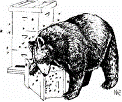Vertebrate Pest Conference Proceedings collection
Date of this Version
February 1982
Document Type
Article
Abstract
Extensive forest conversion of the low-valued natural hardwood forest into coniferous plantations is the possible cause of the critical problem of squirrel debarking. The tree squirrel that causes the major damage is the red-bellied tree squirrel (Callosciurus erythraeus). Conifers are more susceptible to the damage than are hardwood species, especially the exotics. Intermediate-aged plantations appear to have the highest debarking. More damage occurs in the spring than the other seasons. The lower part of the trunk is more heavily debarked than the upper. Debarking is progressively upward to the crown as the tree grows older. Home range, food habit and behavior of the red-bellied tree squirrel are under intensive study and some preliminary results have been obtained. Selection of tree species less susceptible to squirrel debarking has been a main step to control the damage. Intensive weeding and thinning may reduce much of the squirrel preferred habitat and therefore reduce damage. Leaving any natural hardwood forest within or adjacent to the coniferous plantations may provide squirrels with a more attractive cover and food supply. A rice-paraffin bait block of warfarin has been used to poison them with some success. But laboratory studies show klerat (brodifacoum) has a faster lethal efficacy than warfarin. Application of baits and other trapping methods to control squirrel populations need more study and evaluation.

